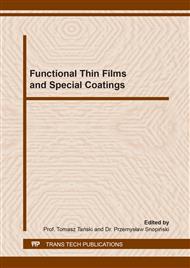p.35
p.51
p.65
p.73
p.83
p.97
p.111
p.125
p.141
Optical Thin Films of Metal Oxides Produced by the Sol-Gel Method for Photovoltaic Applications
Abstract:
The use of thin films in optoelectronic and photovoltaic devices is aimed at improving the physical properties of the substrate material. The modification of the surface of the silicon substrate is thus one of the greatest challenges in research on photovoltaic materials, in order to achieve even greater efficiency or better adapt their properties depending on the application. The technologies of applying layers vary depending on the effect to be obtained and the material from which the layer is formed. In practice, the most common method is chemical vapor deposition and physical vapor deposition, and the most commonly applied optical materials are SiO2, TiO2 and Si3N4.This paper presents the results of investigations on morphology and optical properties of the prepared aluminium oxide thin films. Thin films were prepared with use of sol-gel spin coating method. Surface morphology studies were carried out using an atomic force microscope. To characterize the surface of the thin films, 3D images and histograms of the frequency of individual inequalities were made. In order to characterize the optical properties of Al2O3 thin films, the reflectance and light transmission tests were performed using a spectrophotometer. Optical constants were determined using a spectroscopic ellipsometer. Results and their analysis show that the sol-gel method allows the deposition of homogenous thin films of Al2O3 with the desired geometric characteristics and good optical properties. Uniform, continuous thin layers with a roughness not exceeding a few nanometres were deposited. Their deposition enabled to reduce the reflection of light from the polished substrate below 15% in a wide range (425-800nm) while maintaining high transparencies (over 90%). The obtained results causes that mentioned thin films are good potential material for optics, optoelectronics and photovoltaics.
Info:
Periodical:
Pages:
83-95
Citation:
Online since:
July 2019
Authors:
Keywords:
Price:
Сopyright:
© 2019 Trans Tech Publications Ltd. All Rights Reserved
Share:
Citation:


